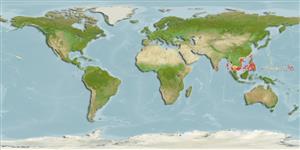>
Eupercaria/misc (Various families in series Eupercaria) >
Labridae (Wrasses)
Etymology: Paracheilinus: Greek, para = the side of + Greek, chaite = hair + Greek, odous = teeth (Ref. 45335).
Eponymy: Dr Kent E Carpenter is Professor of Biological Sciences at Old Dominion University, Virginia, USA. [...] (Ref. 128868), visit book page.
More on authors: Randall & Lubbock.
Environment: milieu / climate zone / depth range / distribution range
Ecologia
marinhas associadas(os) a recifes; intervalo de profundidade 27 - 45 m (Ref. 9710), usually 27 - 45 m (Ref. 27115). Tropical; 25°N - 5°N
Western Pacific: Philippines, north to Taiwan and Iriomotejima, south to northern Bali and Flores (Ref. 37816). Recently recorded from Tonga (Ref. 53797). Replaced by Paracheilinus mccoskeri in the Indian Ocean (Ref. 37816).
Tamanho / Peso / Idade
Maturity: Lm ? range ? - ? cm
Max length : 8.0 cm TL macho/indeterminado; (Ref. 9710)
Descrição suscinta
Chaves de identificação | Morfologia | Morfometria
Espinhos dorsais (total) : 9; Raios dorsais (total) : 11; Espinhos anais: 3; Raios anais : 9; Vértebras: 25. In males, color is generally orange (yellow- or red-orange); lower fourth of head and body pale yellow; 2-4 dorsal soft rays prolonged (every other ray beginning with first). Males larger and more colorful than females; color of males intensify during courtship. Female specimens light red, pale white ventrally. Median predorsal scales 4-6 (Ref. 2139). Penultimate dorsal soft ray of males 1.8-2.2 in HL; two short dark stripes beneath pectoral fin (Ref. 41634).
Found on bases of steep outer reef slopes, above coral or rubble (Ref. 9710). Forms schools. Maximum depth reported from Ref. 27115.
Ciclo de vida ou comportamento de acasalamento
Maturidade | Reprodução | Desova | Ovos | Fecundidade | Larvas
Oviparous, distinct pairing during breeding (Ref. 205).
Randall, J.E. and R. Lubbock, 1981. Labrid fishes of the genus Paracheilinus, with descriptions of three new species from the Philippines. Jap. J. Ichthyol. 28(1):19-30. (Ref. 2139)
Status na Lista Vermelha da UICN (Ref. 130435: Version 2024-1)
Ameaça para os humanos
Harmless
Uso pelos humanos
Pescarias: espécies comerciais; Aquário: Espécies comerciais
Ferramentas
Relatórios especiais
Baixar XML
Fontes da internet
Estimates based on models
Preferred temperature (Ref.
123201): 23.9 - 28.2, mean 27.2 °C (based on 66 cells).
Índice de diversidade filogenética (Ref.
82804): PD
50 = 0.5000 [Uniqueness, from 0.5 = low to 2.0 = high].
Bayesian length-weight: a=0.00977 (0.00470 - 0.02030), b=3.07 (2.90 - 3.24), in cm total length, based on LWR estimates for this (Sub)family-body shape (Ref.
93245).
Nível Trófico (Ref.
69278): 3.4 ±0.45 se; based on food items.
Resiliência (Ref.
120179): Elevada, tempo mínimo de duplicação da população menor que 15 meses (Preliminary K or Fecundity.).
Fishing Vulnerability (Ref.
59153): Low vulnerability (10 of 100).
